

Sullla AGA5: SPGT21 "Five-City Challenge"
v.58
Monarch Difficulty (Russia - Peter)
Epic Speed
I always enjoyed the Five City Challenge game in Civ3, so this game seemed like it would be an interesting run. Since fewer cities does not pose as large of a challenge in Civ4, this game didn't initially appear too difficult - until I saw that it was going to be played on a Large map with fewer than max opponents. Hmm, could get tricky.
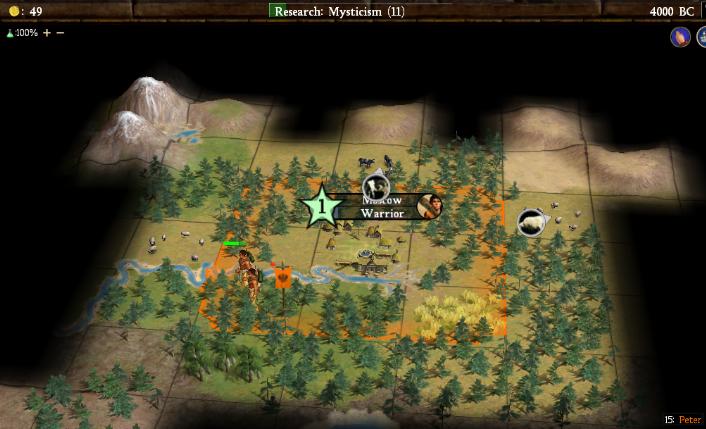
After moving the scout first, I decided to move the settler one tile southwest, which allowed me to still settle in 4000BC on the first turn. You can see this in the picture above; also notice that the resource pointer only identified resources that were present on the screen when it was turned on; the sheep resource to the west was in the fog when I turned it on and thus is not identified. The corn and silks in the south too, for that matter. This probably needs to be fixed to avoid confusion. Initial research choice was Mysticism to pursue a religion; I figured that as a non-Spiritual civ I would probably have to settle for Confucianism again, but might as well start out moving in that direction. Initial build was, not surprisingly, a warrior.
The one thing that immediately jumps out when playing an Epic game for the first time is just how slooooow the game proceeds. This is not a bad thing necessarily, just a bit different. My exploring scout popped a couple of huts, getting The Wheel and gold several times. Bumped into FDR and the Americans pretty early on, running into their scout in 3640BC. I discovered Mysticism in 3560BC and started pursuing Meditation. I wasn't expecting to get to Buddhism first, but the tech was a necessary one for Code of Laws anyway, so it was worth pursuing. Buddhism was indeed founded in a distant land in 3240BC, 5 turns before I would have discovered it. Now what I probably SHOULD have done was try for Polytheism/Monotheism and either or those religions, but I was locked into a "go after Confucianism" mindset as a result of my last game, and so I stubbornly ignored those two religions in favor of proceeding up the top part of the tree. Hinduism wasn't founded until 2320BC and Judaism not until 1125BC (!!!), which had me soundly berating myself in hindsight. Granted, those are Epic speed dates, but I still could have easily had those religions and saved myself a lot of effort. Well, I'll try to improve upon this in my next game.
Moscow started out by building Warrior/Warrior/Scout/Worker. I felt I needed at least two warriors for barb defense (since I didn't start out with one! starting with a scout is nice, but I do feel it leaves the civ wide open to attack). I also wanted at least one more scout (this being a Large map), and I might have built a third except that I popped a free scout from a hut 2640BC. Building that worker took 18 turns (ouch!) when I started in 2880BC, but I still feel it was the best move, since I needed to get those resources hooked up. As far as research, after discovering Meditation in 3040BC, I stopped to pick up Animal Husbandry to be able to build pastures on my nearby resources. After that, I went after Writing (continuing up the Code of Laws path, and also opening up cheap libraries for my civ).
Despite a great deal of care, all my scouts were eventually wiped out by barb animals. At least here on Monarch, they seem to be unable to survive a single battle against anything with 2 strength. I'm not seeing that +100% against animals, but I probably need a larger sample size of evidence. Oh well, it's not like scouts are supposed to be used in battle anyway. The AI scouts seem to survive animal attacks quite easily though, probably because they are getting the Noble barb combat boost, hmmm. In any case, I planned to build the Oracle in Moscow, and slipped in 5 turns of Oracle build between 1925BC and 1800BC while waiting for Writing to finish researching, then swapped over to a Library. I really like the ability to do stuff like that in Civ4. 
Anyway, since I had Writing I had managed to sign Open Borders with FDR and had a warrior over investigating his movements. In 1600BC, the city of Washington popped out a settler and I observed this strange AI behavior:
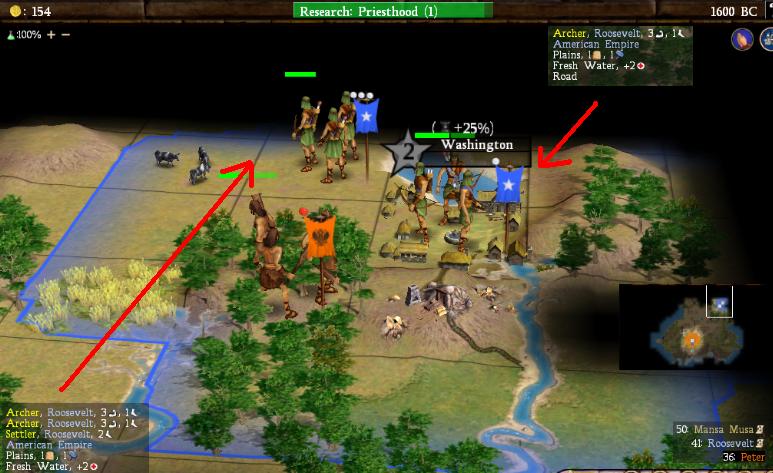
The AI has just produced a settler and is now sending it out with an escort of two archers; this is all well and good. But the city of Washington, the capital of the whole civ, is only being defended by ONE ARCHER because those two have gone out with the settler! Can you say "exploitable AI pattern"? Now I only have one warrior in place here, and am in no position to attack, but it would be very easy to have several archers (or chariots, if there are horses near the starting position, or maybe even horse archers) outside the AI capital waiting for just such a decapitation strike. This MUST be fixed; the AI civs cannot cripple the defense of their capitals when producing a new settler. Red flags all over the place on this particular move.
I was curious to see where that settler would be heading, so I had the warrior you can see above (which had been promoted to Woodsman II and could move at double speed through the forests) tag along with the American settler. The route that this pair of archers and their settler took indicates that the AI pathfinding is being a bit... wasteful.
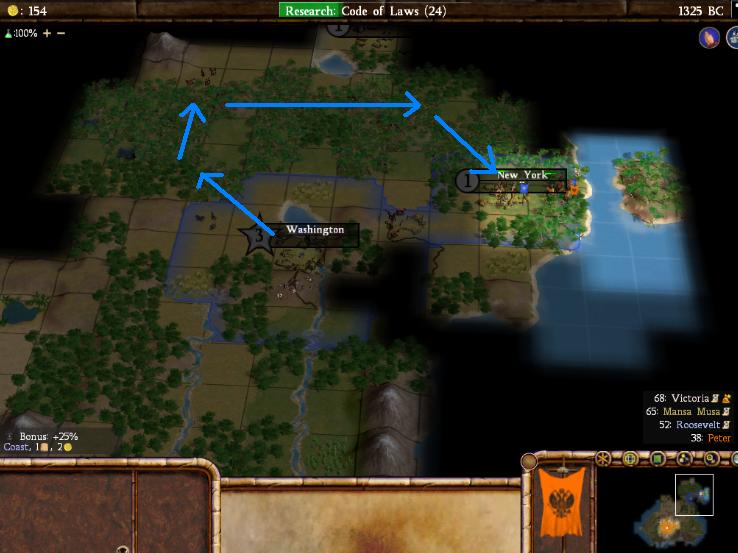
The arrows show the path that the settler took. Northwest out of the capital to where those horses are located, then straight east, then back south again to ultimately settle almost due east of the capital. Simply bizzare; the only explanation I could think of was that another AI civ had taken the location that FDR was going to settle (?) Regardless, there is room to improve things here. Also notice that I've met Victoria (who founded Buddhism) and just how long it's taking to research Code of Laws (it started at 39 turns!)
Back at home, I had finally gotten around to producing settlers after building a library in Moscow. The first settler was produced in 1275BC (if this wasn't an Epic game, that would be incredibly slow!) and I produced a second one immediately after the first, which finished in 1025BC. I already had two sites picked out for those cities, so St. Petersburg was founded first close by the American doorstep in 1175BC. Novgorod followed halfway between St. Pete and Moscow in 950BC. Here's a map showing their locations shortly after being founded:
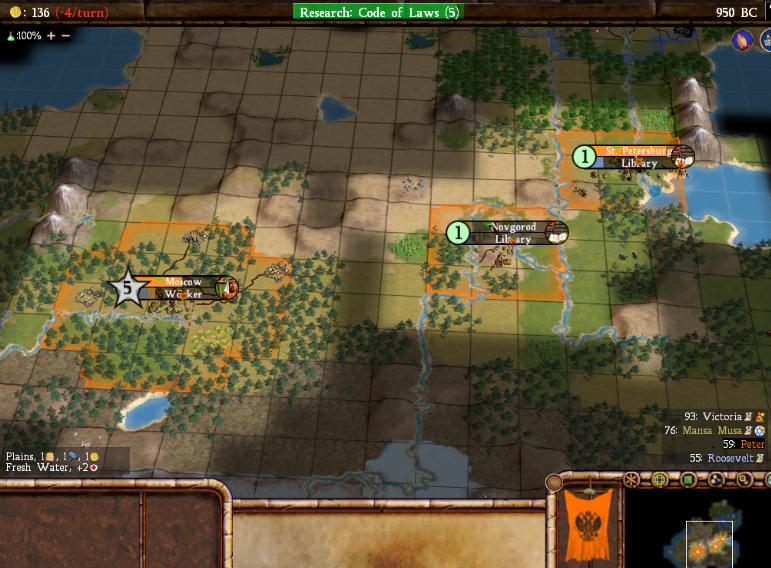
St. Petersburg was the real coup, practically a first-ring site for the Americans that I poached right out from under FDR's nose. There's corn, pigs, and wines located there, and the location is also a river and coastal city. It will clearly be a very strong city down the road. Novgorod is in some ways a space-filler, but also has ridiculous amounts of food. Four floodplains tiles plus a grasslands corn resource; those five tiles together when farmed would produce 21 food even before Biology! I think I have my spot for a Great Person factory, and that will fit well with Peter's leader traits. 
I knew where I wanted to put my final two cities as well, but barb cities popped up right on top of those locations before I could get settlers there. This would delay the founding of my final two cities by a very long time (more on this later). I will be curious to see if a strategy that pursued founding the five cities earlier and faster will prove to be more successful (quite probably).
As you might guess from my determined beeline up the tech tree (I didn't even have Agriculture researched to hook up my corn!), I was the first one to discover Code of Laws and founded Confucianism in 825BC. St. Petersburg became the holy city. The free missionary now posed me with an interesting dilemma; take the obvious move and use him to convert Moscow, or send him north to the Americans (who had no religion of their own) and convert Washington to Confucianism. What ultimately made the decision for me was the fact that this whole game is a part of a testing process; since players are probably going to use the free missionary to convert their own cities 90% of the time, I might as well do something a little unorthodox and see what happens. So the free missionary went north and did indeed convert the Americans to my religion.
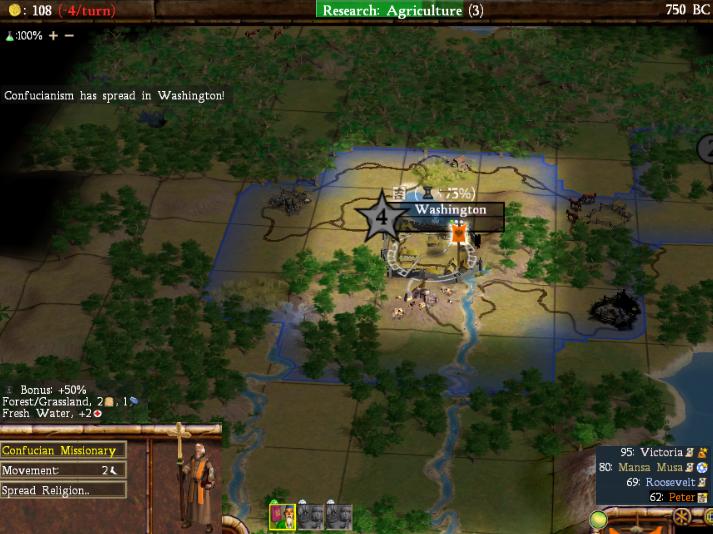
FDR did adopt the religion and spread it around to his numerous cities. The downside, of course, was that Moscow sat with an unhappy person for many turns until I could get a Confucian missionary down there and converty the city to my state religion.
AI Aggression
So everything was running along pretty smoothly in my cities. I had Moscow working on the Oracle to see if I could get it and grab Daoism (again, in a reprise of the move I used in my last game) and the other two cities were building up some basic infrastructure. I was neglecting defense quite a bit, but with FDR the only AI civ within striking distance, and him sharing my state religion and holding steady at "Pleased" relations, I wasn't exactly worried. So when this came out of the blue, I was a little... surprised:
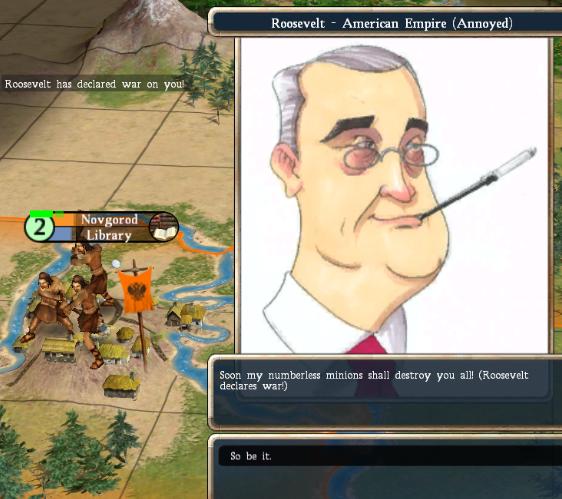
Umm... uh oh. Novgorod has 1 warrior for defense (as you can see) and St. Petersburg had the same. Those cities are both closer to Washington than to Moscow. The best unit I can build is... the warrior. I am in deep doo doo here. 
I'll go into analyzing this AI war declaration in a minute. First of all, the story of what I did to react to it. FDR declared war on the interturn of 675/650BC. The first thing I did in 650BC was to swap my research from Pottery to Archery; the time was listed as 4 turns. That wouldn't be soon enough to build archers in time, but it was better than doing nothing. Secondly, I swapped Moscow from building the Oracle over to building warriors (my best unit!) and sent Novgorod's warrior up to St. Petersburg, and one of Moscow's two warriors towards the front. Meanwhile, FDR sent out his attack force of 1 chariot (which I'll have more to say about in a minute) towards St. Petersburg. Here's a map of the action:
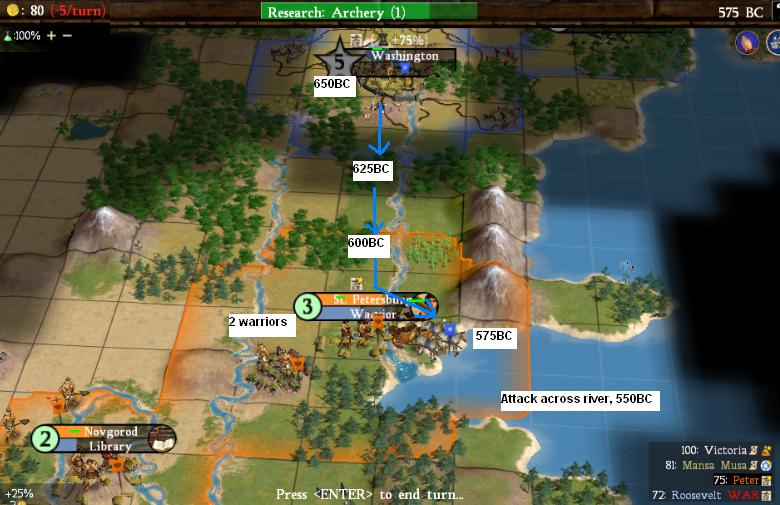
The picture is from 575BC, when I was 1 turn away from discovering Archery (and just barely! whew!) FDR's chariot was in Washington in 650BC, then started moving south. But look at the path it moved! In 600BC, instead of moving south and attacking St. Petersburg, it moved south, southeast across a river! and gave me an extra turn of reprieve. On the 575/550BC interturn, FDR's chariot attacked ACROSS THE RIVER and killed one of my two defending warriors. Now he probably fully expected to take the city on the next turn, but in 550BC I discovered Archery and upgraded my remaining warrior to an archer (oh thank heavens for that upgrade! and I only had the gold as a result of popping huts way back when!) who then defended the city in the 550/525BC interturn when the chariot attacked again. In the Big Huge Dice Roll (TM) that followed, I was successful... barely.
Warriors could be upgraded to archers at this time; this was later removed and warriors given the 25% defensive bonus inside cities to compensate.
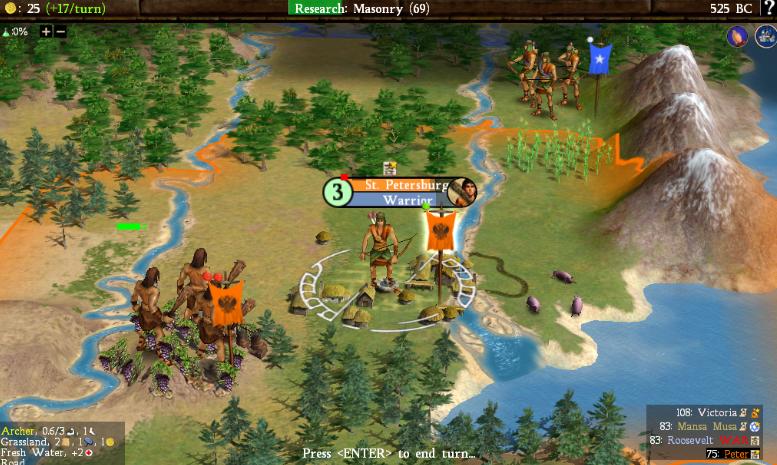
0.6 health remaining saved St. Petersburg, my Confucian holy city, from destruction. There is another American archer heading down to St. Petersburg, but I have another warrior (who was in Novgorod in the previous shot) coming in to protect the city. He would also be upgraded to an archer (you can see I was running 0% science) and then the danger would be passed. I think I upgraded five warriors to archer in total; without those upgrades I would have lost at least St. Petersburg and probably Novgorod as well. I had several tiles pillaged, but I huddled in my cities and managed to get peace in 375BC. Whew! I will never neglect Archery this long on a non-archipelago map again! 
OK, now for what the AI did wrong. First of all, the war declaration in the first place. I'm torn on how to interpret this. Did the AI make an intelligent decision, seeing that I only had warriors for defense, and seek to capitalize on it? Or did it go to war over a dice roll as happens so often in Civ3? I honestly don't know. One thing that IS troublesome is that there was no warning of this beforehand; no drop in relations or anything of the sort. Sneak-attacks are all well and good, and should be part of the game, but everything on the Foreign Advisor screen was telling me that FDR was a friendly civ. We even had the same religion, after all, which I know is a boost to relations. Reloading from autosaves also proved that up until the very turn before the attack, FDR was pleased with me. Pleased, pleased, pleased - boom, at war. That's not a good model for the game to follow. Furthermore, as soon as the war ended, he went right back to being pleased again as though nothing had happened. Also not good.
Then look at how the AI carried out the attack. First of all, if the AI is going to carry out a sneak-attack, the AI should not be doing it with ONE unit! I've been sneak-attacked three times now in the early game, and all three times it was with a single unit. We're in Civ3-land as far as this is concerned. If the AI is going to attack, it has to ATTACK, not dribble in with one unit. I would have been unable to handle even one extra unit in that first wave (which really SHOULD have succeeded). Secondly, look at the path that the chariot took in attacking. Why in the world did it go out of its way to attack across the river?! If the chariot had attacked on the 600/575BC interturn, as it should have, I wouldn't have been able to upgrade my second warrior to an archer and St. Petersburg would have fallen. I'm just at a loss to explain why the unit acted in that fashion. What in the world was it doing?!
Finally, the AI seemed more interested at times in pillaging my tile improvements than attacking. There were a couple turns where the AI could have attacked St. Petersburg and had a legitimate chance to take the city, but passed up the chance to pillage my tiles. In 450BC, there was an archer and a chariot in position to attack St. Petersburg, and only two archers defending, but the expected attacks did not come. This just goes back to the same process I observed in the last SPGT game, which is that the AI is simply not very good at taking cities right now. Pillaging, yes; flooding your territory with units, yes; defending their own cities, yes - but actually caputuring enemy cities? Not at all. This definitely needs some attention at some point if the AI is going to pose a serious threat when the two sides are evenly matched.
Another thing I wanted to point out while I'm on this subject (although not directly related to this game) is that the AI civs are not fighting each other. This is a BIG problem. In close to five complete games, I have seen a total of two (TWO!) AI vs. AI wars that did not involve the player's civ in some way. All the AI civs do is sit and build and build and build without ever having to fight. I don't mind an AI civ coming and taking a shot at me - but they have to face the same threat from the other AI civs as well! If the AI civs are not fighting each other, then we're back to Civ2-land where it's basically the player versus the world, and that is very much not a good thing. One thing I liked about Civ3 was that the AI civs really would go after each other; often taking it to the point where they ruined each other in the process, but that was far more realistic than the Civ2 "let's all sit back and never fight each other" mentality. Blech. We don't need that in Civ4.  Trust me, this really needs to be addressed at some point if we're going to have a realistic AI.
Trust me, this really needs to be addressed at some point if we're going to have a realistic AI.
I stopped last time right after suviving an early war from FDR without losing any of my cities (lesson - build more defense than warriors next time!) I would never go to war again, so the rest of this game was a peaceful building exercise. That's pretty much what I wanted in a Five City Challenge game though!  After getting out of that dangerous early war, I spent a while trying to rebuild the damage that American pillaging had done. Ordinarily it's pretty easy to repair lost tile improvements, but everything does take twice as long in these Epic games. Despite a happiness crunch in several cities from losing my wines, Moscow was able to go back to building the Oracle and complete it in 75BC:
After getting out of that dangerous early war, I spent a while trying to rebuild the damage that American pillaging had done. Ordinarily it's pretty easy to repair lost tile improvements, but everything does take twice as long in these Epic games. Despite a happiness crunch in several cities from losing my wines, Moscow was able to go back to building the Oracle and complete it in 75BC:
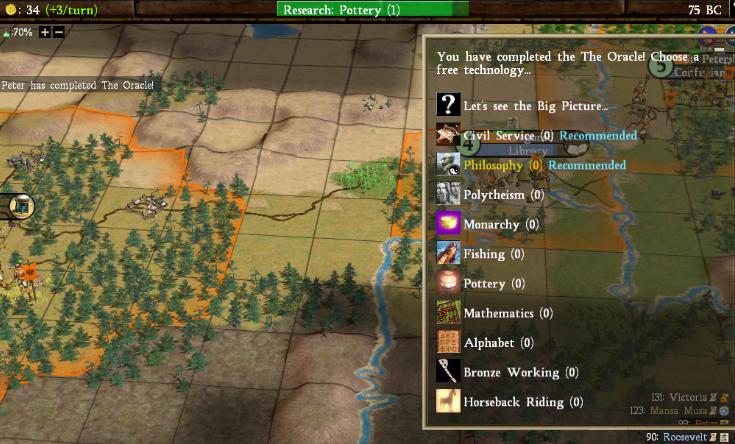
Still researching Pottery there, so I was behind in many ways. I used the free tech to grab Philosophy and Daoism, with St. Petersburg again becoming the holy city. If I could build both shrines in that city and spread the religions around, it could prove to be quite strong commercially (being on a river and on the coast to build a harbor wouldn't hurt either). I thus decided to try and specialize St. Petersburg for commerce, just as Moscow was set up for high shields and Novgorod for high food (and Great Persons). Civ4 lets the player do this to a much greater extent than in previous Civilization games, and it's a great deal of fun straetgizing the individual cities.
OK, so after Confucianism spread to Novogorod, I noticed that it was getting 1 culture/turn from having the state religion present. Is this the way the game's going to work? 1 culture from state religion? It's fine either way, present or not, but I'd just like to find out one way or the other for my own sake here (I swear I've seen it sometimes provide culture and sometimes not).
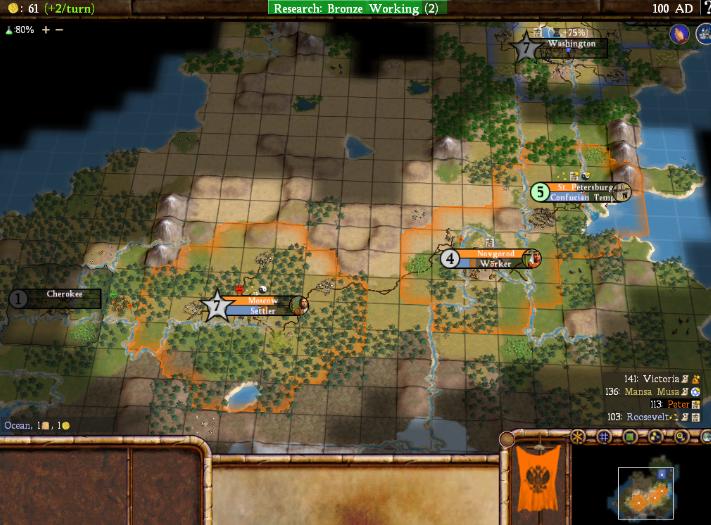
My three cities right after the turn over to AD years. Moscow's building a settler to put in the southeast, but a barb city formed right on the very tile where I was going to found in 180AD. This might sound beneficial, but it actually slowed down the founding of that city for centuries as I had to build up an attack force to conquer the barb city. The settler instead went to the west, where I founded my 4th city after razing Cherokee (it was one tile off from where I wanted it). That attack took place in 400AD, with six archers fighting three barb ones; in a bloodbath, I barely managed to take the city (4 of the 6 died). Still, the combat odds went about right; my problem was a lack of horses or copper or iron, thus nothing better to build than archers. Rostov was settled in 420AD.
After that, things were very quiet for a while. One of the things about the Epic game speed is that there are long stretches of time when relatively little is going on (at least, when you only have five cities). It's fine for a change of pace, but probably too slow to play all my games on it. Building the Oracle paid off for me in 720AD as my first Great Person was a Prophet. He went to build the Confucian shrine in St. Petes, completing it in 780AD. Novgorod meanwhile began its attempt to culture-bomb the city of Chicago, which was foolishly settled nearby. I ran a bunch of Artists in the city (using Caste System) and got my borders to expand, but was unable to get the city to revolt even a single time. I did get a Great Artist out of the deal for my second Great Person though, in 960AD. Here's a picture of that offending city of Chicago:
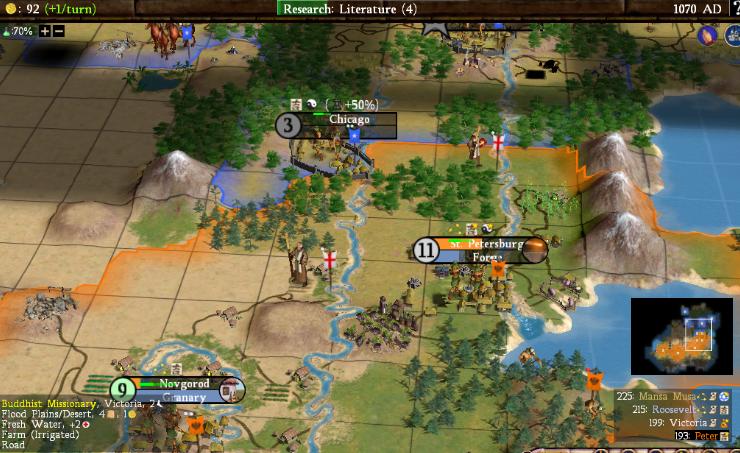
Despite all this pressure, I never saw Chicago revolt even once. I think Sirian may have under-estimated the difficulty of getting enemy cities to flip. This is fine with me; I'm not a big fan of culture flips, but it seems to be that the flip will be very rare indeed; a Great Artist will probably be needed in most cases. Also notice that the AI is now using Missionaries; Buddhism and Judaism were eventually spread to my cities with AI missionaries, which I was fine with since it let me build more temples.
Alright, back to Novgorod again. This city had so much food that it was begging to be used as a Great Person factory. I was happy to oblige, and used (abused?) Caste System to great success here:
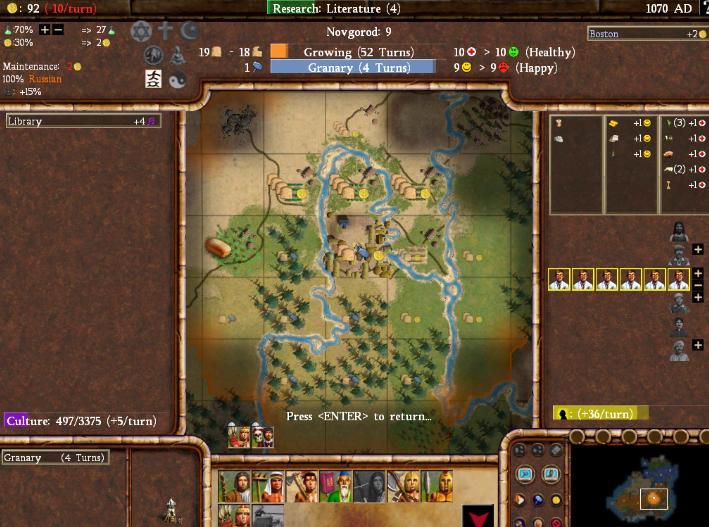
There's a size 9 city there supporting no fewer than SIX scientists (I think one is from building the Pyramids and swapping into Representation). I think we need to be careful with the Caste System civic; I really like it right now, but for high-food cities like Novgorod, it can definitely tip the scales over into exploitative behavior. Keep in mind this is an Epic game, with all Great Persons requiring 150 more points each time instead of 100 - and I don't have the Heroic Epic built in this city, or any wonders/GP settled in the city to generate extra GP points. I can easily see a clever player setting up a situation where a city like this keeps generating GP at an alarming rate, using them for techs or settling them in the city to generate more GP at an even faster rate. I've got an even better picture of Novgorod to display later. What I'm trying to say is, let's be careful with Caste System. I'm not ready to call for the nerf yet, but it may well need it eventually. I'll try to experiment more with it to find out.
Novgorod naturally produced a GrScientist from all those specialists, which I used to build an Academy in St. Petes in 1150AD. After completing the Pyramids, Moscow built a barracks and 5 Axeman, who went after the barb city that would be my fifth and final city. It was 5 Axes (all with City Raider I) vs. 3 archers in a city behind walls; I only lost Axeman, but had several close battles. Olmec fell in 1210AD:
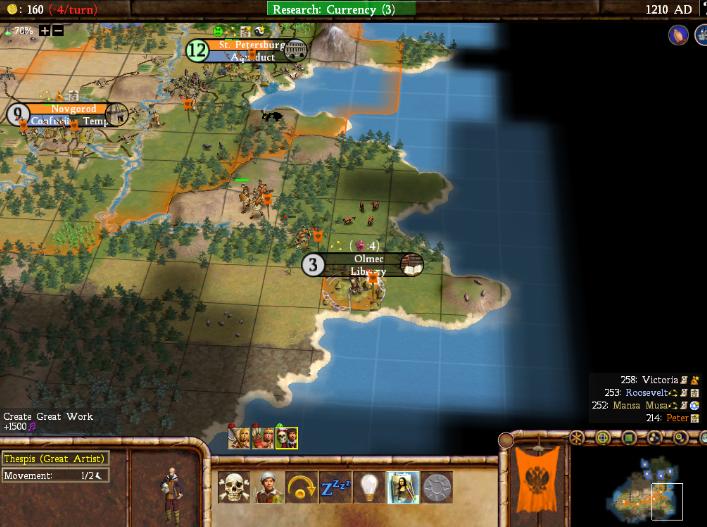
Above you see my GrArtist ready to create a great work in the captured city. (Oh, and for this version, culture from great works was screwed up; it provided 1500 culture, but three border expansion was actually 15^3, or 3375 culture. I think Soren has since fixed this - aside from mixing up the Quick and Epic speeds! - so no need to say more on this now.) I wanted to see how useful the instant border expansion would be, so I tried it out here and discovered something unusual. Check the "after" picture below:
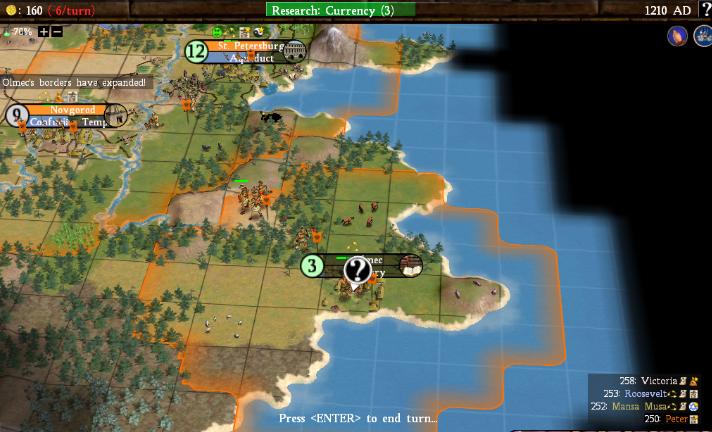
Notice something unusual? The city came out of revolt when I created the Great Work! I don't know if this is a bug, but if so, let's leave it in! Now there's another reason to hold on to Great Artists - not only do they provide instant culture, they bring captured cities out of revolt!  If this is actually a design feature that I'm just not aware of, I apologize for getting worked up over nothing, but it seemed pretty noteworthy at the time.
If this is actually a design feature that I'm just not aware of, I apologize for getting worked up over nothing, but it seemed pretty noteworthy at the time.
I never learned if this was a bug or intended behavior but the Great Artist culture bomb ending resistance in a captured city remains in Civ4 to this day.
Things continued to be pretty routine. Fortunately, I now had my five cities, and Olmec was able to catch up to the other cities pretty quickly. I decided to have it emphasize commerce (since it was on the ocean), and built a bunch of cottages in its tiles. Rostov, in the west, was another shields city, and it produced tons of missionaries that I used to convert foreign cities. I got beat to Notre Dame by 4 turns in 1300AD, which was a bummer but did give me a nice injection of cash. A trade mission from a Great Merchant in 1415AD added another 2850g - not too shabby. This allowed me to keep the research rate high; I never dropped below 80% at any time in this game. I also built the National Epic in Moscow around this time, which I thought increased Great Person production by 100% in all cities (it's actually only in the city that builds it). D'oh! Novgorod really could have benefited from that. Well, maybe in my next game...
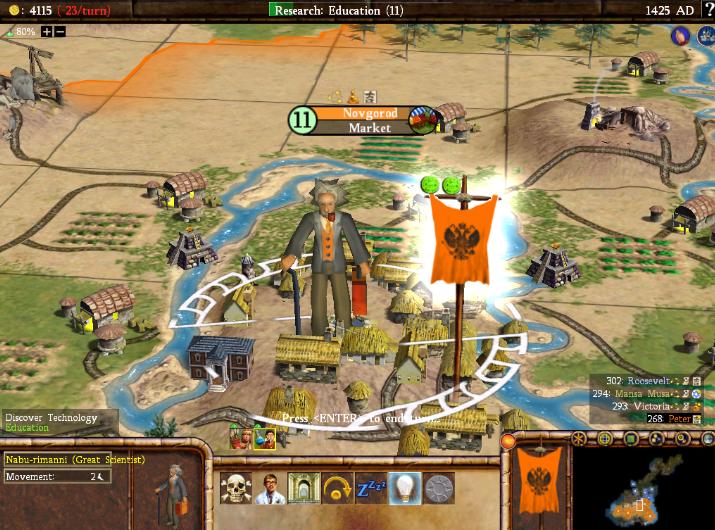
I had popped another GrScientist out of Novgorod in 1410AD, and decided to hold onto him for a couple of turns. After discovering Paper in 1425AD, I woke up the Scientist and decided to have him grab Education for me. I got that tech first, naturally, and took Divine Right from it. Olmec became the Islamic holy city. I had no desire to spread Islam around; it was just a denial move to keep the AI civs from having another religion. The free missionary failed to spread Islam to St. Petes, and so I sat with Islam in only one city for practically the whole game. Heh.
I also built Chichen Itza (probably my favorite wonder) in here using my Stone resource. Novgorod had plenty of food, but it had NO shields whatsoever; I had it sitting on 1 shield/turn for literally ages. Using Bureaucracy and Chichen Itza, I cash-rushed all of its buildings. That wonder is still extremely strong, but at least it expires now. Probably no further need for a change. I also picked up an additional GrProphet in Moscow around this time (1515AD) and used it to build the Daoist shrine in St. Petes, which by now was starting to rake in the shrine income.
The free tech was originally located at Education, where it was even more susceptible to being grabbed with Great Scientist lightbulbs, before being moved to Liberalism and forcing the Philosophy tech cross-tree requirement. At the time, Chichen Itza also discounted all rushed production by 50%. This was extremely powerful, made more so by the fact that cash-rushing unlocked much earlier at Bureaucracy civic / Civil Service tech. The effect was so powerful that it was eventually moved all the way back to the Kremlin wonder in the late Industrial era.
I had known there were two continents in this world since the minimap gets revealed when loading a save (uh, we might want to mix that bug soon). I wasn't able to get a ship over to the other continent and make contact until 1635AD, when I met Alex and Hatshepsut.
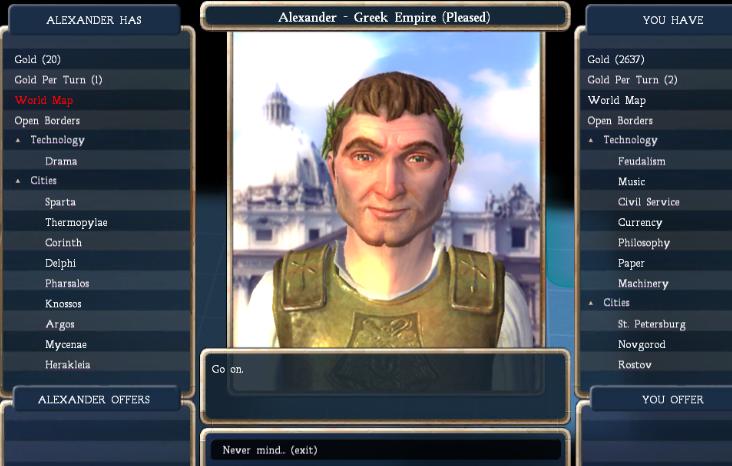
Yeah, he's behind. One nice thing about Civ4 is that Alex and Hatshepsut did NOT immediately catch right up to the other AI civs. They slowly made up some ground on the tech front, but remained several techs behind even at the close of my game. I take this as a positive sign; gone are the days of Civ3 where 2 turns after making contact all the AI civs would have traded techs among themselves and caught each other up. I don't know how many times in games of Civ3, we would say "how in the world did ____ get the money to catch up so fast?" Now the AI civs really do have to research their way up the tech tree, and the isolated civs have to work their own way out of their hole. This is looking good to me. 
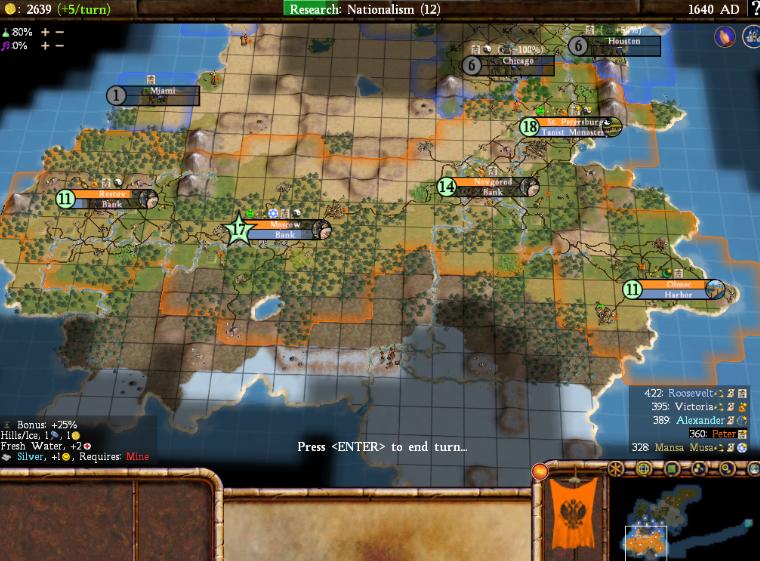
My world in 1640AD. Can you guess which tech I had just discovered? (hint, it rhymes with "Tanking")  Unlike Aeson, I still have tons of forests left to chop, many of which I was saving to build lumber mills. I would indeed chop most of them down later, and probably should have taken down more of them earlier. I'm still getting used to this aspect of Civ4. Those extra shields definitely would have benefited me more earlier rather than later, hmmm... I think there's room for improvement in my playing here. I'm going for Nationalism here en route to the free Great Merchant at Corporation; I would in fact get that tech first in 1750AD, at the cost of having to skip Gunpowder and Rifling for a very long time (don't try this in multiplayer!)
Unlike Aeson, I still have tons of forests left to chop, many of which I was saving to build lumber mills. I would indeed chop most of them down later, and probably should have taken down more of them earlier. I'm still getting used to this aspect of Civ4. Those extra shields definitely would have benefited me more earlier rather than later, hmmm... I think there's room for improvement in my playing here. I'm going for Nationalism here en route to the free Great Merchant at Corporation; I would in fact get that tech first in 1750AD, at the cost of having to skip Gunpowder and Rifling for a very long time (don't try this in multiplayer!)
I had swapped over from running scientists in Novgorod to merchants, which allowed me to up the science rate to 90% and still get a slight profit. The other side effect from this was the generation of tons of Great Merchants, which are never a bad thing to have around (in the mid-to-late game, I think these may be the most valuable GPs). Here's a shot of one of them delivering his bundle of goods to the Malinese capital for a whopping payout:
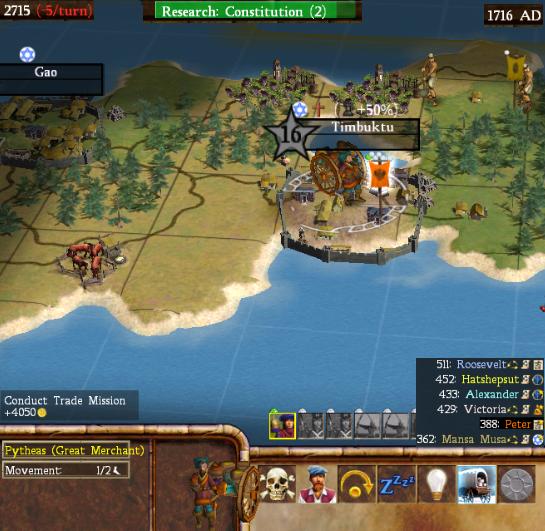
Yes, that's 4050g there. Pretty nice!  Of course, that's largely due to this being an Epic game, but it was more than enough to keep my researching humming along at 90%. The free GrMerchant from Corporation went on another trade mission to the same city that brought in another 4050g. Then, I generated yet ANOTHER GrMerchant in Novgorod in 1766AD that did the same thing. Cha-ching! I was filthy rich. More on that in a minute; first, look at what my missionaries were able to do in America:
Of course, that's largely due to this being an Epic game, but it was more than enough to keep my researching humming along at 90%. The free GrMerchant from Corporation went on another trade mission to the same city that brought in another 4050g. Then, I generated yet ANOTHER GrMerchant in Novgorod in 1766AD that did the same thing. Cha-ching! I was filthy rich. More on that in a minute; first, look at what my missionaries were able to do in America:
Yes, Corporation tech once awarded a free Great Merchant to the first one who discovered it. This was a little too snowbally, letting civs who were ahead run even more deficit research to get further ahead, which is why it was later moved to the dead-end Economics tech.
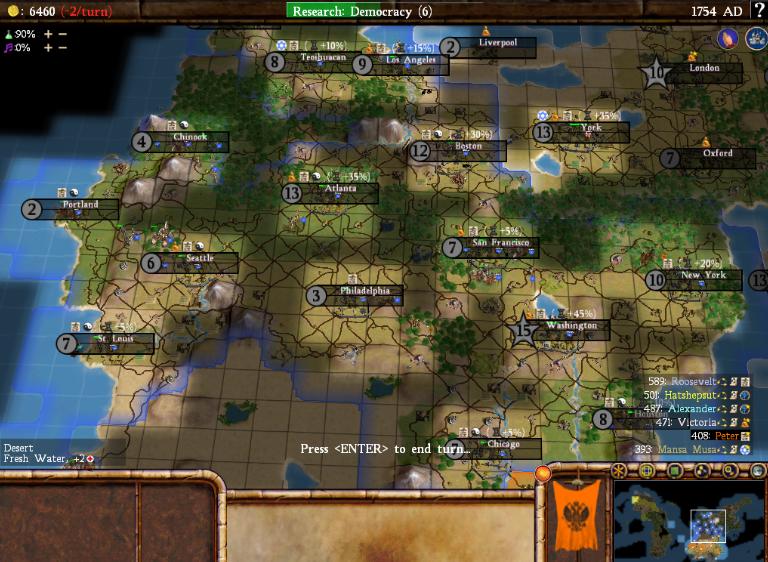
I managed to convert every single city to Confucianism, and I got Daoism in almost all of them as well. Some of that spread was from FDR himself, but the vast majority was with my own missionaries. St. Petes meanwhile was enjoying some serious shrine income, over 40 extra commerce between the Confucian and Daoist shrines. Then it was getting an additional 35 or so commerce from its harbor trade routes. Yikes. By the end of the game, it was a research monster, getting almost 400 beakers/turn without Oxford (which I couldn't build with only 5 cities) or a Lab. I think I could have hit 500/turn before game's end, and more than that with Oxford. This is my favorite thing about Epic speed games: you get the extra time needed to move missionaries around. Here on a Large map though, it had me wondering, especially when I started spreading Confucianism overseas to Egypt. Should we scale the number of missionaries for larger maps? Having 4 missionaries instead of 3 would have been really helpful on a map of this size. I think it's something to consider, if nothing else.
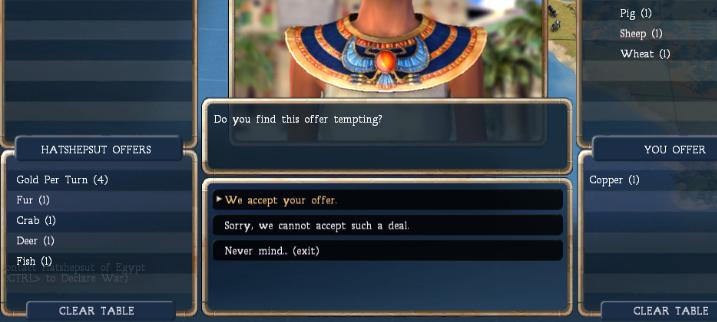
Wow, Hatshepsut really wants my copper, doesn't she? This is probably too much for the AI to give away for one strategic resource, and an outdated one like copper at that (we're about to enter the Industrial Age here). Two of those resources would probably be more than enough. It might be a good idea to make sure that the AI doesn't give away too much to get its hands on outdated strategic resources. In other matters, the AI is trading very intelligently; I made a number of tech deals in this game, but every time the AI was getting something just as good as I was picking up. The fact that the AI civs won't trade monopoly techs or ones for which they're building wonders makes the AI much stronger than it was in Civ3. As far as trading goes, the AI is performing quite well (other areas of AI diplomacy still need some work). The demands have also been reduced to a tolerable minimum, so good work on that as well.
In 1774AD, I discovered Liberalism and went into the great civics swap. I changed 4 of my 5 civics all at once, going through a three-turn anarchy period (which is really a lot for Civ4). Specifically, it was Hereditary Rule -> Representation, Caste System -> Emancipation, Free Market -> Federal Reserve, Organized Religion -> Free Religion. Now two of these moves were quite beneficial; I no longer needed to be in Hereditary Rule and Representation was a clear benefit, and with many different religions in my cities, Free Religion was clearly superior to Organized Religion. The other two are where some interesting things came up.
I expected that Emancipation would be a clear winner over Caste System, but to my surprise I found myself having all kinds of problems in Novgorod after switching over. The problem was simply that I had so MUCH food in Novgorod, that I was running more specialists than the buildings constructed there would let me support. I quickly realized that my situation would be improved by going BACK to Caste System and being able to run unlimited merchants once again (I was limited to I think 4 otherwise). After discovering Biology and getting a food explosion, that led to this picture:
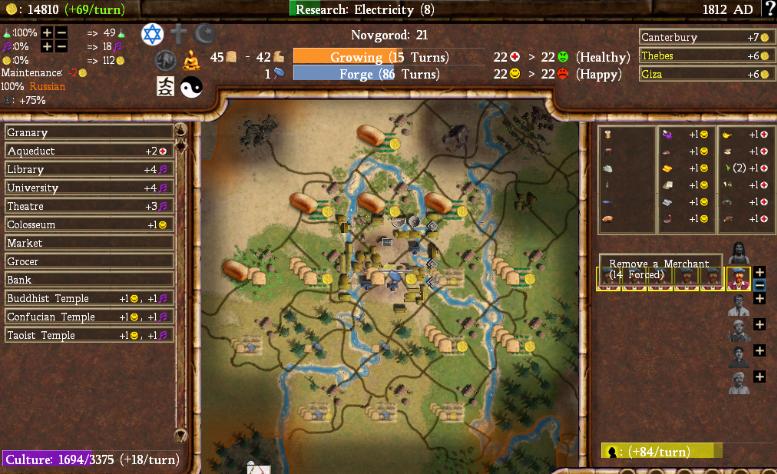
That's right - I'm running FOURTEEN merchants in Novgorod!  They are paying for the entire upkeep of my civilization by themselves. Keep in mind, I DON'T have Wall Street built in this city (I can't build it with only five cities) and I also don't have the Heroic Epic here either - or else I would be getting 168 GP points/turn. Yikes. Again, I'm not calling for the out and out nerf on Caste System yet, just trying to illustrate that so long as it provides UNLIMITED specialists, players are going to find clever ways to make use of it. This is a little bit of an extreme example, but it's in there nonetheless, and I made use of it. I wonder if I could have gotten to 20 merchants by the end of the game if I had kept on playing? Probably, and it would have been fun to try.
They are paying for the entire upkeep of my civilization by themselves. Keep in mind, I DON'T have Wall Street built in this city (I can't build it with only five cities) and I also don't have the Heroic Epic here either - or else I would be getting 168 GP points/turn. Yikes. Again, I'm not calling for the out and out nerf on Caste System yet, just trying to illustrate that so long as it provides UNLIMITED specialists, players are going to find clever ways to make use of it. This is a little bit of an extreme example, but it's in there nonetheless, and I made use of it. I wonder if I could have gotten to 20 merchants by the end of the game if I had kept on playing? Probably, and it would have been fun to try. 
The other civic that I had an unexpected result from was Federal Reserve. With over 15,000g in the bank, I should have been reaping large benefits, right? Wrong. Sure, I could run 100% research with a slight profit (roughly 5-10gpt), but other than that it wasn't doing much. The big plus you see in the above screenshot is due to the wealth that Novgorod is pumping out, not due to the Federal Reserve civic. Even with this much gold in the bank, I was only getting 75g out of the civic, and that's just not a big enough deal to make the swap. And keep in mind that I conducted four trade missions of 2850, 4050, 4050, and 4050 gold (total of 15,000g) in this game, and still wasn't seeing a huge benefit. The problem with Federal Reserve is its exponential nature; either it's ridiculously overpowered (as I understand it was in some of the earlier builds) or it's toned down to the point where it contributes practically nothing. Either way, there's basically no middle ground. I see it's been scrapped in v.60 and I say good riddance. I just don't see any place where it could fit into the game without being too strong or too weak.
Federal Reserve civic granted gold per turn income equal to a percentage of the player's current treasury. It was removed for exactly the reasons my past self identified here: either game-breakingly overpowered with the percentage set too high or completely useless with the percentage set too low. Some mechanics can't ever be balanced properly because they're simply bad design and Civ4 was better off without this concept.
In case you couldn't tell, I enjoyed this game immensely, and would have continued playing if my computer didn't start crashing almost non-stop as I progressed further along. I'm not sure exactly why I kept getting call stack violations; I think some of them were due to the instability of the build, and probably my computer's lack of virtual memory also contibuted. As my computer started to run out of memory en route to crashes, weird stuff started happening. I took some pictures of these bugs:
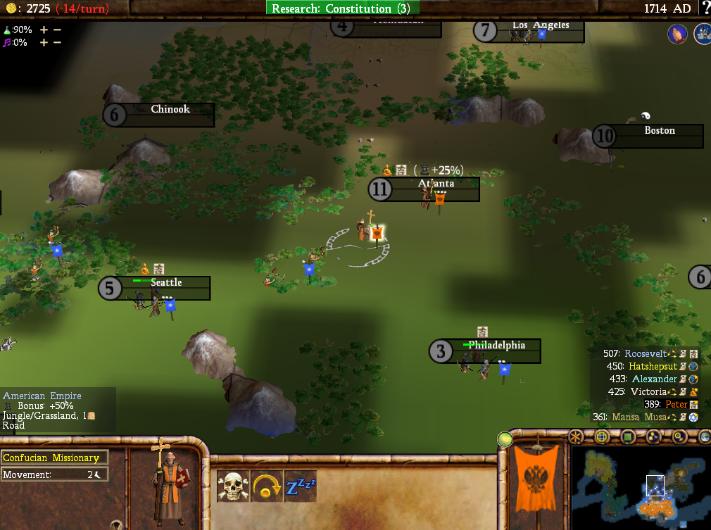
This happened quite a few times, the ground flickering back and forth between its proper setting and this "pea soup" display. It would flicker in and out as I scrolled in and out using the mouse wheel. This was always a sign that my computer was running out of virtal memory and heading for a crash (Civ4 is a huge hog of computing power!) Pretty strange picture.
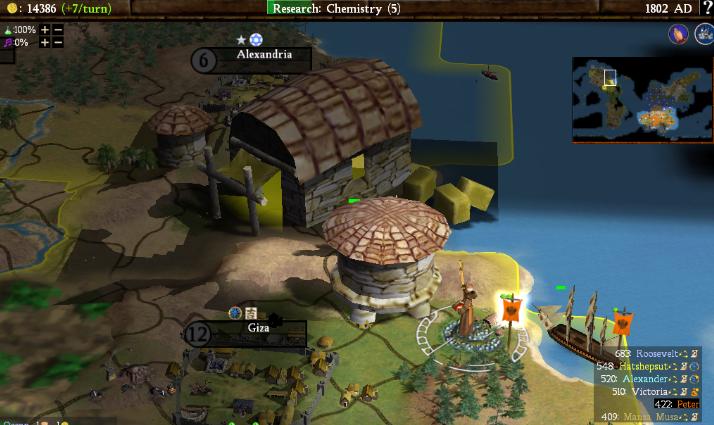
My missionary better watch out, because in order to get to Alexandria he has to pass by the giant's house. 
Or - look, we finally have houses to match the size of the giant units! 
More seriously, I don't know what caused this; one of the buildings on the map is being displayed at a gigantic size. Dunno why this happened, but I only saw it once. Made for a good picture though.
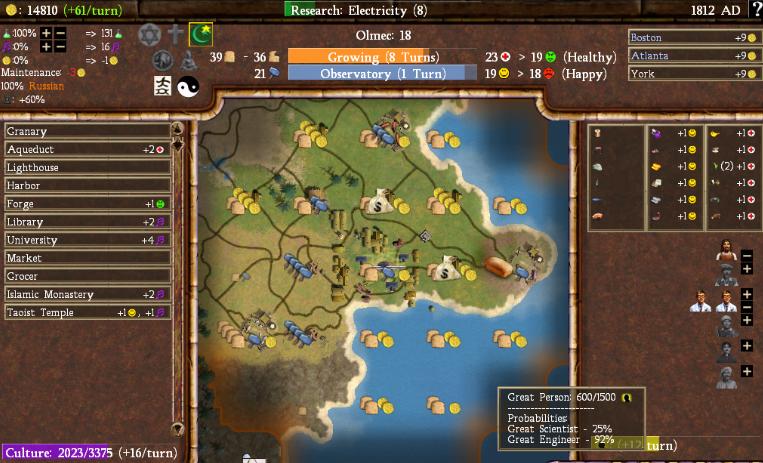
Great Person probabilities again not adding up; 92 + 25 = 117%, which would appear to be "fuzzy math". I also want to know how the city of Olmec can be producing NEGATIVE ONE gold per turn, but that's another matter entirely.
As far as the game was going, I was staying pretty competitive despite a score near the bottom of the pack (ironically, Mansa Musa and I had the least territory and were the two tech leaders! what a welcome change from Civ3). Mansa Musa had the tech lead, but I was usually a tech or two behind; we kept taking different research branches, and occasionally trading the techs we discovered. The others were all a bit behind, although FDR and Victoria weren't too far back. The other continent remained backwards. For only five cities, and with no access to some helpful national wonders, I thought I was doing a pretty decent job. I had gotten my research pace over 1000 beakers/turn, and it would have been a fun space race to try (although I'm pretty sure I would have won since the AI stinks at building the spaceship, at least from what I've observed). But when the game is crashing every 10 turns and has thus slowed down to a "Rogue Revival" pace  , it's time to stop. Thanks for the game Sirian.
, it's time to stop. Thanks for the game Sirian.
Ending map:
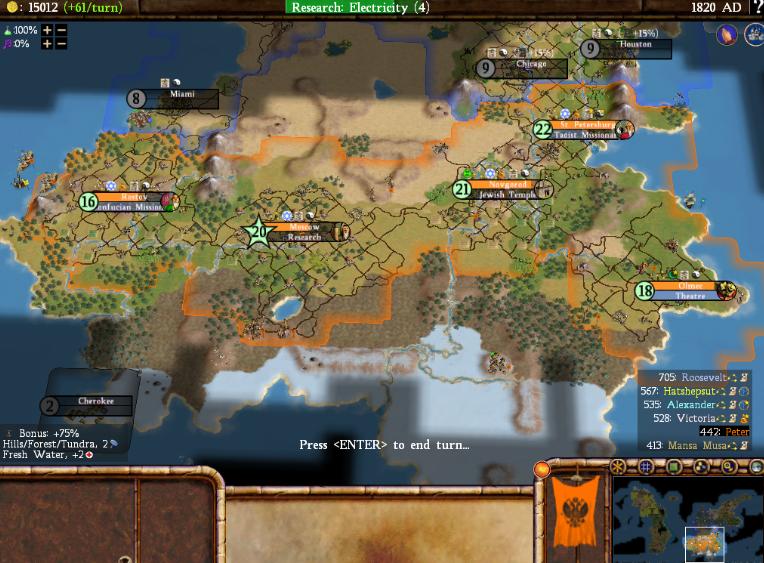
(By the way, are we ever going to get the minimap working right? It never shows up the foreign cultural borders correctly on my computer.)



